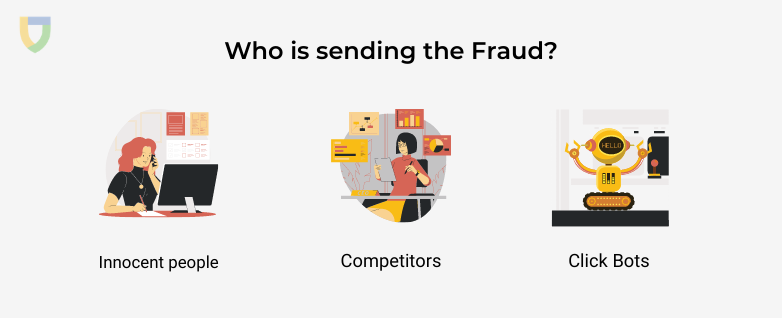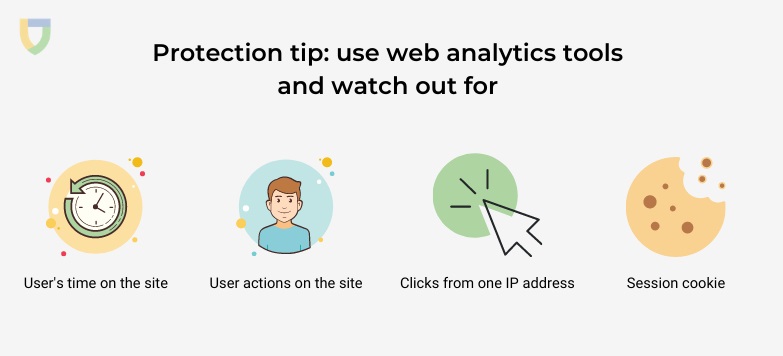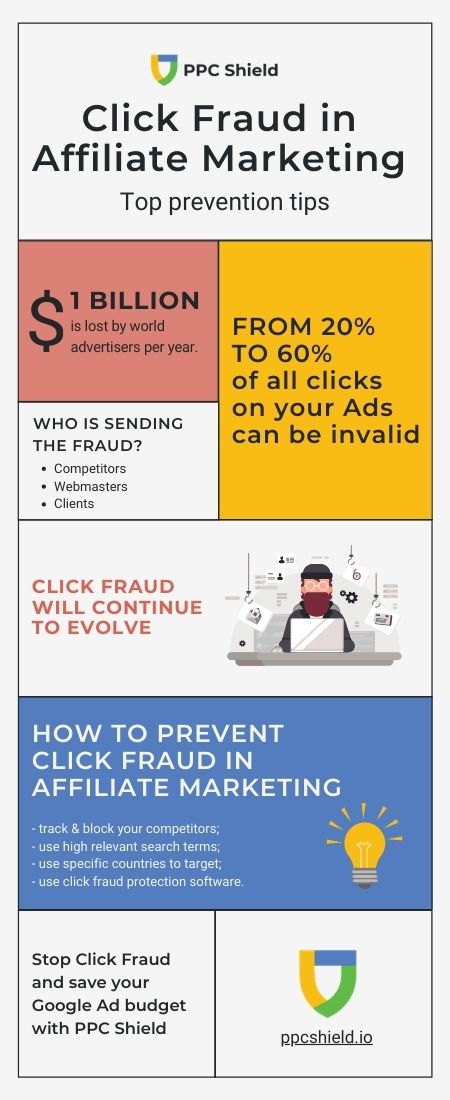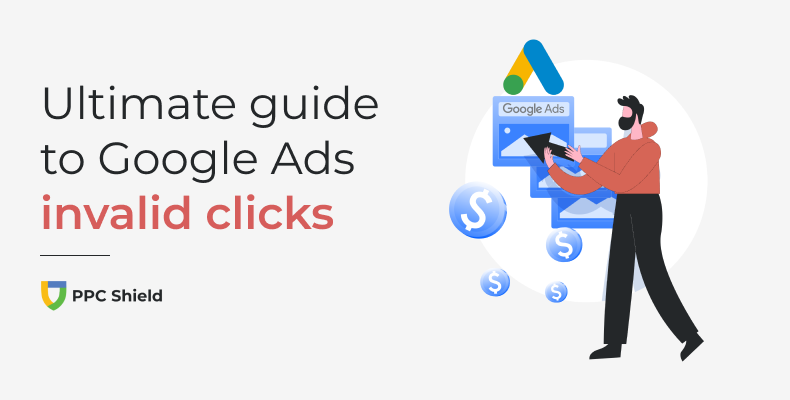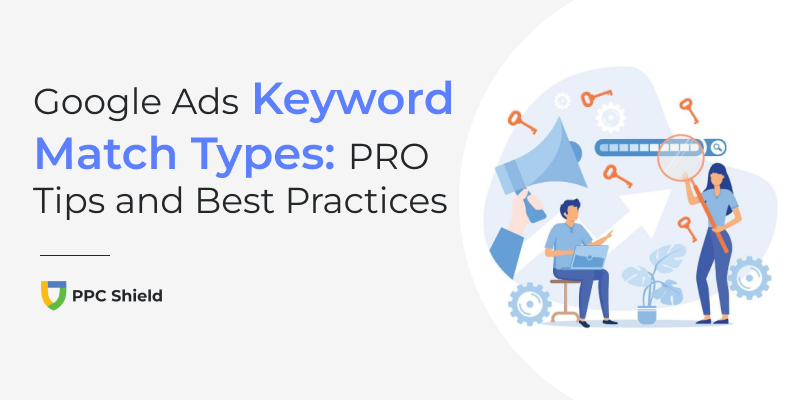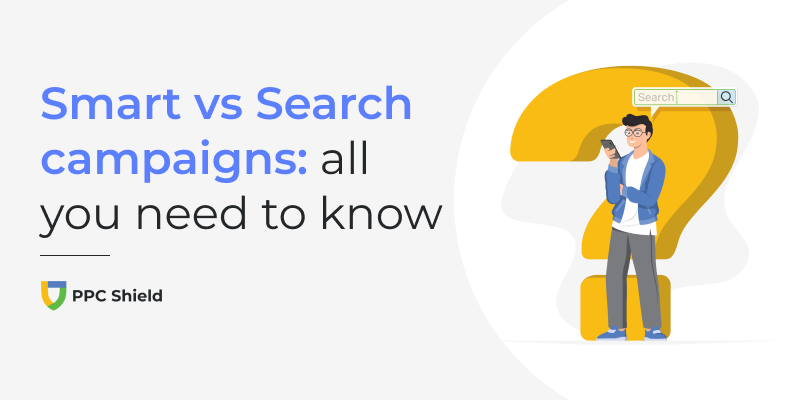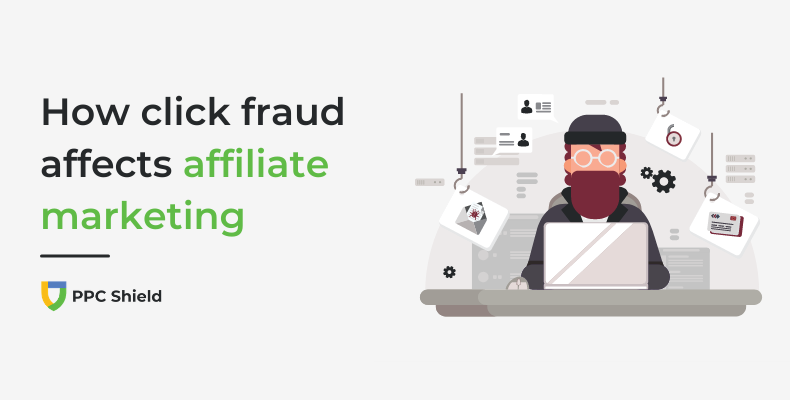
A recent report from Adobe says 28% of web traffic comes from non-human sources. Non-human traffic is accountable for most of click fraud.
The reputation of search engines suffers significantly because of it, so search engines like Google are constantly working on measures to suppress illegal actions of click fraud.
This search engine can control several indicators at once: the IP address from which the ad was clicked, double-clicking, “winding up” clicks in a short period.
Unfortunately, only a few click frauds are found, since fraudulent methods are regularly updated.
Already familiar with click fraud? Skip to the main must-read parts: click fraud prevention tips for affiliate marketers or TL;DR Infographic.
What is Click Fraud?
Click Fraud is one of the most deleterious phenomena for digital advertisers.
Its action is multiple and carried out with malicious intent.
Click fraud is when a person, computer program, or generated script attacks advertisers by repeatedly clicking on a PPC ad to increase ad spend, lower conversion rates, and distort performance data (eventually, it also negatively impacts the ROI).
How does Click Fraud work?
Click fraud is clicking on an online ad, usually with malicious intent.
This could be due to “draining” the advertiser’s budget in an attempt to remove ads from search results or redirect ad spend to third parties or scammers.
These fake clicks on your paid ads can cost anywhere from a few pennies to over a hundred dollars, depending on the CPC (cost per click) of your ad.
Click fraud can affect any form of paid advertising, including paid search results, banner ads, video ads, or native ad content.
How to detect fraudulent clicks?
Have a careful look at your website metrics. When you see a spike in traffic, check your analytics right away.
You will probably see something like this: irregular difference between current and average values. You might have been attacked, if you see one or few of these signs:
- Abnormally high CTR. A huge number of "visitors" enter the site and leave it quickly.
- User session times are over 50% lower than your average.
- Bounce rate is over 40% (however, this may also mean that you have poorly configured your ad)
- Visitors without cookie files might be scammers who don’t want to leave a trace. However, some target users might also disable cookies for security reasons and visit sites in private.
Click Fraud in Affiliate Marketing
It’s a fast-growing and hard to control problem.
Fake leads and bot scams significantly affect many factors, from cost per click to search engine reputation.
Scammers have expanded their reach a lot over the past few years, creating fake installations of software and mobile apps, and even automating the submission of fake user information in CPL lead generation campaigns.
Click fraud has been increasing the impact on advertising every year.
In percentage terms, invalid clicks can reach from 20% to 60% of all clicks on your ads, significantly affecting your ROI.
Click Fraud Types and Who is Doing It
We’ve all done it, whether you’re not paying attention, making a mistake, or misreading the link.
Sometimes you click on something you didn’t want.
Some of your clicks will be wasted due to people mistakenly clicking on your links.
Some of these human clicks are not all that innocent. Click fraud can also result from people who do not intend to interact with your site clicking on your links.
It could be a former employee or competitor trying to get you to burn your ad budget faster without having the results. They do this for their ads to appear higher on the search results page. This is usually relatively low because:
- It’s boring to do.
- Competitors typically have their businesses.
It can get worse if a group of people (like an entire office) clicks on your ads.
For example, if the CPC is high, 20 people clicking a £10 link can quickly accumulate and cut your budget.
Like human clickers, bots can be both innocent and vengeful. You will have to accept that some of your income will be lost to indexing scanners due to a number of them on the Internet. Most of them innocently index the Internet.
However, some bots were explicitly created for advertising. You can buy clicks and interactions for a specific profile on a social network or website.
Thus, unscrupulous competitors or other fraudulent people can use the power of technology to squander your budget.
We are raising the level of potential volume and severity. Click farms are either automated or human-driven interaction centers. Usually, human click farms are based in developing countries where wages are low.
Click farms are used by businesses across an extensive range of industries. Have you heard of celebrities and brands who buy followers on social media? It is a click farm.
By connecting phones and tablets to a computer, these farms can automate hundreds of people’s activities, making them a powerful tool for creating fake digital interactions.
Click fraud tactics used by criminal gangs are to create websites (or hundreds of thousands) that then host ads from the audience network, such as your beautiful ad.
They then use bots to simulate clicks on your ad from their website, so it looks like this fake site is incredibly popular. These clicks generate revenue for their website from the audience network and increase your ad budget.
One of the most infamous installations was known as Meth bot. It was a very sophisticated network of rogue bots designed to fraudulently collect money for video views using a network of computers. It is believed that the Meth bot was created in Russia, and it is estimated that it makes about $ 5-6 million per day from ad clicks.
If you see that your budget is unsuccessfully exhausted, then your ad has been attacked by a click farm or fraudulent system.
The speed at which the budget is spent depends on the size of the farm clicks (the more people are involved, the faster the budget will be depleted).
Who needs this?
Typically, the main scammers can be divided into four different categories.
Competitors
Webmasters
Clients
click for more info
Fraud "rings"
How to Prevent Click Fraud in Affiliate Marketing
Although click fraud is a rapidly growing problem, there are several ways to avoid fraud and protect your advertising.
Use specific and highly relevant search terms. Scammers usually don’t do good keyword research and use the most basic and popular search terms for clicks. Using well-defined specific keywords (including long-tail keywords) is your assistant in the fight against fraudsters.
Use specific countries for the target. Some countries have a bad reputation for click fraud. There is a list of countries that are not recommended for launching ads, as there the click-fraud percentage is several times higher. Therefore, it’s best to limit your targeting by location and exclude those countries that are more likely to waste your budget.
Track your competitors. As we wrote earlier, one of the primary sources of click fraud can be your competitors’ ads. Therefore, if you are sure that the clicks are coming from competitors’ offices, then the easiest way to stop them is to use geolocation exclusion.
Use software to protect your ads from Click Fraud. There is software that detects fraud, blocks it, saves your money, and improves your ROI. PPC Shield has an advanced filter to detect click frauds; after detecting, the algorithm can restrict malicious IP addresses from accessing your advertisements and thereby save your budget.
2024 Best Protection Practices for Affiliates
To prevent click fraud, it is necessary to improve the monitoring system for campaigns using web analytics tools.
Services should analyze questionable clicks and adapt to new fraud methods based on the following criteria:

User’s time on site – transitions, where the user left the page immediately after clicking on the link or banner, fall under the status of doubtful.
The number of clicks from one IP address. The more such clicks, the more likely it is to be a scam.

Session cookie. Scammers do not work with programs that use cookies, in order to not leave trace of their fraudulent activities.

User actions on site, such as mouse movements and page scrolling. With the help of video monitoring tools, you can observe user’s behavior on the site and, in case of the absence of human-like behavior, classify such situation as click fraud.
The Best Click Fraud Monitoring Tools
The easiest way to stop click fraud is to use fraud prevention software. Acting as protection against fraud, it stops intruders and detects suspicious activity that you can check through software. This is the most cost-effective solution, especially if you spend more than a few hundred thousand dollars a month on PPC ads.
PPC Shield click fraud prevention software is easy to use, actively prevents your paid ads from being clicked by fraudsters, and provides you with real-time data.
Summary: What You Need To Know as an Affiliate
Unfortunately, click fraud will continue to evolve.
Don’t worry! Here are our tips to stop click fraud:
Monitor your ad traffic and watch for unexpected traffic spikes, high bounce rates, and low conversions.
Remove bids for keywords that attract high traffic and low conversions.
Add IP addresses to the blacklist and experiment with the timing of your ads.
Use negative keywords to prevent your ad from showing on numerous low converting searches.
Automate click-fraud prevention with the industry-leading protection software, PPC Shield. Upon signing up, you will be able to see the number of click fraud attempts on your ads and make better data-driven decisions for your future PPC campaigns.
TL;DR Infographic
Save it and share with fellow affiliates who also need to know about click fraud.

